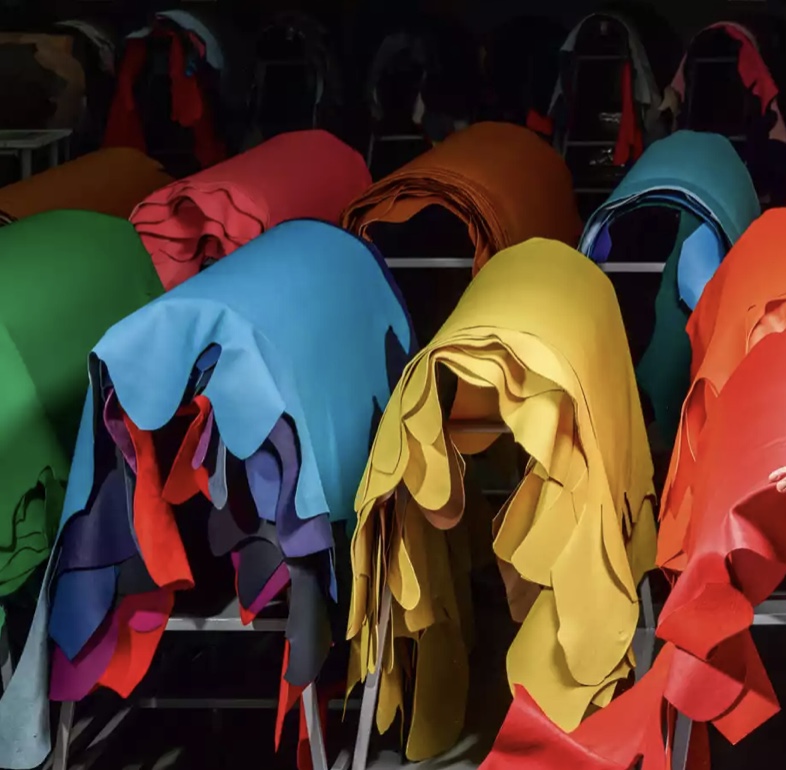There is so much happening in the leather industry, time for a blog about this beautiful material. My great love and passion. I am not a tanner, but the interest in the basic material has always been there. Nice it to know how your material is put together, isn’t it? This allows you as a maker/creator to make better choices, just as a cabinetmaker wants to know what his kind of wood does and where it comes from, and a painter wants to understand his paint and his brushes. And so there are numerous examples.
The leather industry used to be quite a polluting and dirty business. Nowadays, fortunately, there are regulations to protect the environment and wonderful initiatives to make a more responsible product.
The leather industry faces a major image problem. Did you know that then 65% of young adults think cows are kept for their skin? Well, not at all. Leather is the processed wasteproduct of the meat-dairy and wool industries. What happens to the waste? We throw it away. What a waste! Surely it makes much more sense to use that skin!? This ignorance must be reversed. Educate and share clear and honest information. Transparency, I think, is also what society demands these days.
The leather industry is not standing still. Everywhere you see a huge flight on pursuing of a more circular economy, initiatives to reduce the ecological footprint of the industry and to make sure sustainability is high on the agenda.
For example, tanning processes nowadays are highly sustainable and work with biodegradable substances.
What is tanning anyway? Neutralizing the protein structure in the skin. If you don’t, the skin is going to rot by itself. Just like a discarded apple. So tanning in the right way ensures that you get your hands on a durable product that will last a very long time.
Many of the skins today are tanned in such a way that they are totally biodegradable. A fantastic fact, this is how Mother Earth remains intact!
Another myth that needs to be dispelled concerns chrome-tanned leather. This has nothing to do with the toxic chromium-6 that we know from the media from the paint on trains and army equipment*. What is used are chromium-3 salts. These are soluble and were/are flushed out of the final product.
The newly developed tanning agents no longer involve chromium. Currently, the process of Zeology tanning, on which Nera (part of the firm Smit & Zoon from Weesp) holds several patents, is the cutting edge technology. Nera has developed a tanning agent on the base of zeolite, a material composed of the most abundant elements in the earth’s surface. The tannin allows tanneries to produce chrome-free biodegradable leather. Thus, Zeology contributes to the joint creation of a socially and environmentally sustainable learning value chain.
Chemical use in the leather and textile industry is monitored by the ZDHC (Zero Discharge of Hazardous Chemicals); a globally established NGO consisting of representatives of major brands, suppliers and other stakeholders in the leather and textile chains. The ZDHC aims to eliminate the use of hazardous chemicals in both the leather and textile industries and improve wastewater quality through regulation, monitoring and enforcement.
Where does leather actually come from? Most -certainly 99%- is from cattle, sheep, goats and pigs. All these animals are kept and slaughtered for the meat, dairy and/or wool industry. So their skin is a wasteproduct. My opinion is, as long as we keep and use animals on earth, let’s use all of it and not waste any of it out of respect for life, instead of throwing it in the garbage pile.
By the way, did you know that in corona time, millions of hides ended up in landfills in Brazil, one of the largest leather-producing countries? What a waste! Worldwide, we would have an unimaginable 7.3 million tons of waste per year if we did not process the skins. Just think for a moment…, that would be crazy, wouldn’t it?
Just a few more advantages of leather; leather lasts a very long time and actually only gets more beautiful with time. It is repairable, you can recycle leather, leather has countless possibilities to apply. Think furniture, car interiors, super soft gloves, clothing, bags, shoes and what about technical applications like belts and gaskets? Leather has another advantage: it is very comfortable. It has breathability, is moisture-wicking and molds to the user over time. Furthermore, leather is organic and has a natural beauty.
All these wonderful new developments are also making the skins traceable. This is in its infancy now but in a few years it will become very common. Then you can trace the leather of almost any product back to its source. That way we have even more transparency. Did you know that a Dutch tannery, Vitelco leather, is leading the way in this?
Another NGO organization providing certification for the leather industry is the Leather Working Group (LWG). They conduct traceability audits at their member tanneries. This means that tanneries must be able to indicate the origin of their hide material. This information is available to all on the LWG website. In addition to making leather more traceable, this group also reduces water consumption, provides fairly paid jobs and is committed to combating deforestation!
Another aspect is the “Footprint” of leather; the set of materials consumed and energy required to make something, set against the product’s durability and utility. We all want to keep these as small as possible, don’t we? New tanning techniques can reduce water consumption and the environmental impact of chemicals.
By the way, most tanneries have their own water treatment plants. There are strict rules for this. Leading tanneries are developing methods to process their waste in a circular way, creating new materials and generating energy.
Think about your footprint, a leather bag or belt, how often you wear it and how long do you think it will last? A plastic bag (one of those shopping bags) might last 3 months while a leather bag can last up to 50 years. Also, that leather is bag is 100% biodegradable, while that plastic bag will remain floating around in the environment for years to come.
I find the quote; “Buy less, buy better, buy leather” very appropriate here.
I am quite a bit proud that pioneers in this field, Smit & Zoon and Vitelco Leather, are Dutch companies. They help make the world of the leather industry more beautiful. How glad I am to live in this country!
And then a little fact from the past, with in the back of your mind all these above new developments.
Leather workers of all shapes and sizes.
Although leather today is predominantly a residual product of the dairy, wool and meat industries, it is a highly sought-after and extremely versatile product. Working animal skins into garments is undoubtedly one of the oldest crafts. The material can range from thick, strong, stiff and hard to supple, soft and smooth like silk. For example, the Greek hero Ajax protected himself from the spears, arrows and sword strokes of the Trojans with a large shield strung with the hard, smoked hides of oxen. And Ötzi, the 5,000-year-old mummified Ice Man found in an Alpine glacier, had leather from 5 different species of animals incorporated into his clothing and other equipment. The combination of great strength with suppleness, wear resistance and pleasant wearing properties makes leather very suitable for numerous applications. Bags, shoes, clothing, furniture and belts are all familiar to us, but leather also has unique applications in industry and engineering. For example, as insulation, sealing and gasketing. For example, the great industrial revolution of the 19th century was unthinkable without the countless leather driving belts that transmitted power from steam engines to all kinds of devices and machines. Coaches were comfortable due to smooth spring suspension with leather straps. And, of course, there is an ancient use of this beautiful material for horse rigging. From saddles to harnesses, bridles and reins. Each application had its own specialists; leather workers were distinguished in the fields of footwear, bags and belts, clothing, saddles and harness and driving belts. Much of the specific expertise of these artisans has been lost.
But so there are fantastic new developments, so beautiful.
Therefore -and as a granddaughter from a family of tanners- I feel it is important to pass on the professional knowledge I have acquired over 35 years to a new generation of lovers of this beautiful material.
If you find this piece important enough, please share.
Benefits the leather industry!
* (Chromium-6 is a metal compound that is or was used primarily because of its anti-corrosion property. Chromium-6 is harmful to health and can lead to cancer, among other things).

